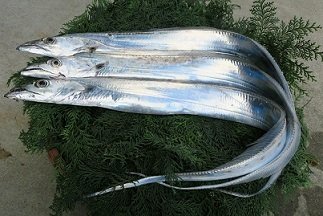Toyoshima Tachiuo
| Registration Number | 84 |
|---|---|
| Name of the GI | Toyoshima Tachiuo |
| Class | Fish and Shellfish |
| Date of Protection | 2019/09/09 |
| Producing Area |
Hiroshima Prefecture
Seas off the coast of Toyoshima in Toyohamacho, Kure City |
| Applicant - Name and Address | Kure Toyoshima Fisheries Cooperative 4136-22 Toyoshima, Toyohamacho, Kure City, Hiroshima Prefecture |
Producing Area
Toyoshima Tachiuo is cutlass fish caught by a fishing technique without using fishing nets, which has been inherited among fishermen in Toyoshima.
It is characterized by its shiny scratchless skin and freshness, thanks to their skilled technique and throughout freshness control.
In recognition of its scratchless skin and freshness, Toyoshima Tachiuo is sold at market for prices 20 to 30% higher than cutlass fish from other areas.
Toyoshima Tachiuo are caught in seas off the coast of Toyoshima in Toyohamacho, Kure City, Hiroshima Prefecture.
Toyoshima Tachiuo are caught one by one with trolling, paying special attention to keep damage or scratch on the fish to a minimum on fishing vessel. Fish with no scratches or peeling on the skin and with the tail remaining intact are packed by size into Styrofoam shipping boxes and instantly killed in ice before shipment.
The seas off the coast of Toyoshima have both fast and slow tides, which create a fishing ground rich in Japanese sand lance and other small fish species that cutlass fish feed on.
Fishing of cutlass fish began in the region around 1955, with catches amounting to around 4 tons at the time (1957). Catches increased after around 1970, reaching 106 tons in 1973 and 1,962 tons in 1980.
The current freshness management has been practiced since around 1970. The present Toyoshima Fishing Port is equipped with large-scale ice-making and freight handling facilities required for cooperative consolidation and shipment, where landed cutlass fish undergo pre-shipment sorting and checking.
Due to the recent decrease in both fish and fishermen throughout the Seto Inland Sea (1), shipment volumes of Toyoshima Tachiuo are very sluggish: 301 tons in 2013, 245 tons in 2014, 184 tons in 2015, and 115 tons in 2016. This has prompted local efforts to develop successors of the fishing technique, including actively accepting new fishermen.
- Seto Inland Sea: An inland sea surrounded by the islands of Honshu, Shikoku, and Kyushu. The Sea consists of many island groups, and is known for having rich ecosystems. It is also known for a large difference in tide levels, with the seawater flowing like river water in some areas. These strong tides generate the Naruto whirlpools, which are known widely as some of the world's largest whirlpools.


